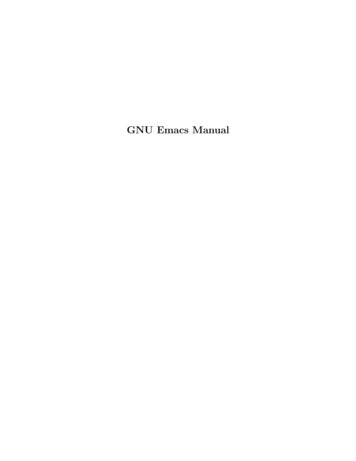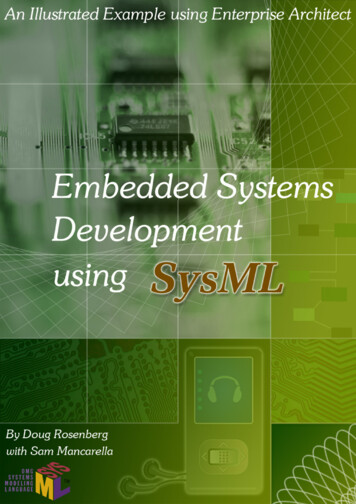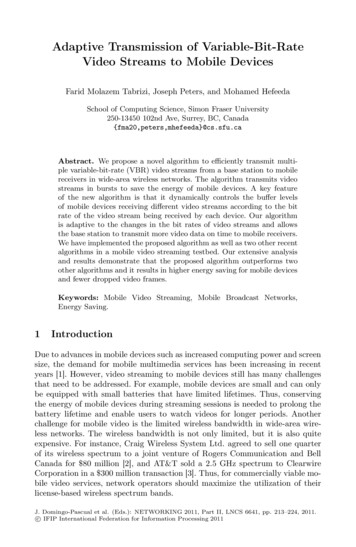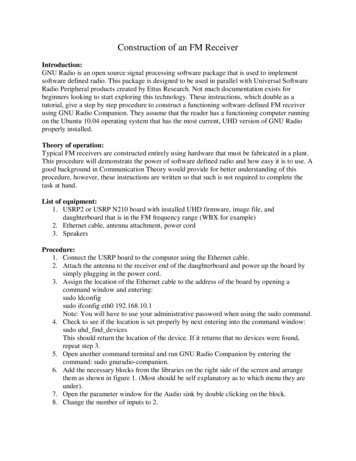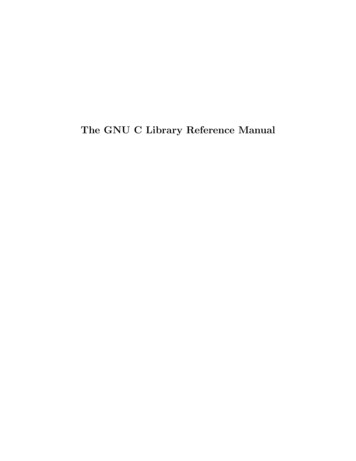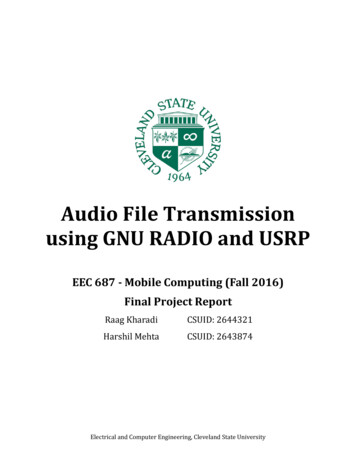
Transcription
Audio File Transmissionusing GNU RADIO and USRPEEC 687 - Mobile Computing (Fall 2016)Final Project ReportRaag KharadiCSUID: 2644321Harshil MehtaCSUID: 2643874Electrical and Computer Engineering, Cleveland State University
IntroductionIn radio engineering radio engineers were facing problem related to chip computing power so theyhad to think again to redesign of radio receivers. Since, from many decades’ hardware for radiotransceiver consist of signal were down converted to intermediate frequency then filtered and thendemodulated after converting to baseband signal. After few years around 1980’s digital signalprocessor leads to development of digital transceivers. This kind of digital transceivers requireshardware for just for limiting frequency to narrow band frequency and then ADC and other portionof architecture consist of software interface so this kind of transceivers leads to so-called SoftwareDefine Radios(SDR’s). In SDR there is general purpose processors and other devices which performsignal processing are integrated in FPGA.Software Defined RadioIn SDR there are certain stages in receiving and transmission chain where signal is digitized and usingsoftware techniques computation is done on digital radio signal. The main aim of this SDR is toconvert almost all hardware system problem into digital domain problems so it can be easilymodified and problems can be solved easily. In general, SDR consist of Antennas, an ADC andsubsystem defined in software domain.Thus, there are certain conditions to be followed to implement software define radios which are asfollows:1. Antennas which are used for any specific system should be capable for all radio signal ofinterest that to be operated.2. So design for ADC and DAS would be such that its sampling rate must be grated than twicethe frequency than that for signal of interest.3. Thus, the unit which does task for processing should be capable of enough processing powerto process signal of interest.Figure 1. Software Defined Radio Block DiagramElectrical and Computer Engineering, Cleveland State University
Universal Software Radio Peripheral (USRP)The USRP is developed by Ettus Research LLC. who are involved in developing of SDR platform formgeneral purpose computers. The USRP we use here knows as USRP 1 in which motherboard consistof four ADCs/DACs which are capable for fast and effective performance these are connected to radiofront end daughterboard. There is programmable FPGA Chip on motherboard which is connected toPC through USB. Figure 2 show USRP’s motherboard and daughterboard which are used in ourproject also there are other list of daughterboard that are used for different frequency band.Figure 2. USRP Main Board and Basic TX and Basic RX Daughterboard 1-250 MHz Tx/RxTypes of Daughterboard.Following are list of Daughterboard with its band range and cost1.2.3.4.5.6.7.8.9.Basic TX and Basic RX Daughterboard 1-250 MHz Tx/Rx - 140LFTX -- DC-30 MHz Transmitter and Receiver - 154TVRX2 50-860 MHz Rx x 2 - 205DBSRX -- 800 MHz to 2.4 GHz Receiver - 155RFX400 -- 400-500 MHz Transceiver - 275RFX900 -- 800-1000MHz Transceiver - 275RFX1200 -- 1150 MHz - 1450 MHz Transceiver - 275RFX1800 -- 1.5-2.1 GHz Transceiver - 275RFX2400 -- 2.3-2.9 GHz Transceiver, 20 mW output - 275Electrical and Computer Engineering, Cleveland State University
GNU RadioGNU radio provide software environment for developing and which is open source and free of costsoftware and also has inbuilt signal processing blocks for implementation of software radios. Forcreating SDR it provides less cost RF hardware and it also provides stimulation like user interfacewhich does not required physical hardware. It is widely used in real radio systems and for researchrelated work for wireless communication.ImplementationFor implementation in GNU Radio their certain blocks which are pre-defined in gr library, this blocksare been created in C as low level programing while python is used to build graphs as high levelprogramming and as interface between them (Simplified Wrapper and Implemented Generator)SWIG is used.Figure 3. GNU radio framework structure1. Practical Implementation using WBFM Modulation/Demodulation SchemeFM TransmitterIn practical implementation the modulation technique used here is wideband frequency modulation.When the highest frequency component of a modulating signal is greater than the peak frequencydeviation of modulated signal, then it is called as wide band frequency modulation.Following are detail description for block for building WBFMFigure 3a WBFM Transmit: The message signal is then passed through WBFM block which takes theinput signal and gives the frequency modulated signal as an output. Audio rate and quadrature rateare the sampling rate of input and output signal. You can give any value to Max Deviation as long asit is greater than 20kHz (highest frequency component of a (sound) message signal). Also Figure 3bshows FFT sink properties of after WBFM block to see exactly how is signal look after Modulation.Electrical and Computer Engineering, Cleveland State University
(A)(B)A.Properties of WBFM Transmitter.SourceB. FFT Sink Properties to Display Signal after WBFM.(C)C.CarrierSignalD. Flow Graph of WBFM TransmitterFigure 4. WBFM TransmitterFigure-4d shows the detail flowchart of the FM transmitter. In the implementation of the FMtransmitter, we sampled the audio at 48 kHz, the rate at which it was stored, then converted it to 192kHz using WBFM. After that it sent to the Rational Resampler for some interpolation and decimation.Then we multiply the cosine signal to reduce the effect of noise at high frequencies, and passed it tothe USRP. The USRP up converted the FM signal to 96.9MHz and transmitted it.Electrical and Computer Engineering, Cleveland State University
1. Here our main aim is to transmit some audio file to the destination so we are going to use afile source (here wav file source) and not the USRP. In the Wav file source we have to choosethe input file source where we store our audio file.2. Figure-5 shows the graph for our Wav file before the WBFM block.Figure 5. Original Wav file signal3. Then this input file is sent the WBFM block where audio rate is predefined. Here quadraturerate is set in the multiple of 48 and this rate is the outgoing sample rate whereas 48kHz isincoming sample rate. The modulated signal is shown in Figure-6 below.Audio rate: 48 kHzQuadrature Rate: 48 kHz * 4 192 kHzTua: 75uFigure 6. Signal after modulationElectrical and Computer Engineering, Cleveland State University
4. After that this sampled signal is sent to the rational Resampler. Where we are doing somefrequency conversion. For example, the Audio Sink needs lower frequency and USRP blockneed higher then this block converts the frequency by doing some interpolation ordecimation as per the requirements.5. Now output of the rational resampler is feed to one of the input of the Multiply block. Secondinput of the multiply block is Cosine signal with the 192 kHz sample rate. Here this carriersignal is used for proper transmission.6. Figure-7 shows resulting signal after multiplier.Figure 7. Multiplication of carrier signal and modulated signal7. Now these multiplied signal is sent to the USRP sink from there signal is send to thedestination using wireless medium. Here we use 96.9 MHz as center frequency but it canchange using freq selection slider and antenna is connected to TX/RX daughterboard.Figure 8. Multiplication of carrier signal and modulated signal in time domainElectrical and Computer Engineering, Cleveland State University
FM Receiver1. Here we are trying to receive FM channels using USRP that is why our input source is goingto be USRP block with centre frequency of 106.7MHz which can be adjusted with the help ofText Box. Here sampling rate is 4MHz and other properties are as below:Gain Value: It is managed by rf gain slider with min 0 and max 30.Antenna: Connected to TX/RX in daughter boardFigure 9. Modified FM Receiver2. Now the output of the USRP block is going to the low pass filter. Here filter passes the signalwhose frequency is below the cutoff frequency (here it is 100kHz) and also it deduces thesignal with higher frequency.3. Figure 10 shows the graph of the received signal at the input of USRP.Figure 10. Resulting Graph of Input Signal4. Now filtered signal is given to the wide band FM block. This block demodulates the wide bandfrequency signal from data stream. So at the output we get the original data stream whichsent by the sender.5. Output of the WBFM block sent to the Rational Resampler. Here we decimate or interpolatethe data stream according to the application to the desire rate. For example, the Audio Sinkneeds lower frequency and USRP block need higher then this block converts the frequencyby doing some interpolation or decimation as per the requirements.Electrical and Computer Engineering, Cleveland State University
Figure 11. Resulting Graph of Low Passed Signal6. Figure 11 is the graph of demodulated data stream in frequency domain.7. Finally, Audio sink block is used to listen the sound of the received channel.Combined ImplementationFigure 12 below shows the combine receiver and transmitter flow graph where we tune into our FMchannel using GUI Text Box which is used to receive the FM channels. The USRP block takes thisfrequency as its center Frequency and shifts it to origin to make it a baseband signal. Thus changingthe center frequency of the USRP, we can tune to various channels. In this implementation we usebasic Rx so it can work only in certain frequency range i.e. 1-250MHz. Also the antenna has to be inthe frequency range in which you want to receive the signal, so in the beginning, reception was notat all audible. After successfully receive the FM channel it is feedback to transmitter portion. Nowwith the use of this transmitter we transmit that channel to the another frequency (here it is 106.9MHz). So, in general we receive an audio from one channel then play from laptop’s soundcard andbroadcast it from transmitter and listen to another channel using mobile phone.1. Here we are trying to receive FM channels using USRP that is why our input source is goingto be USRP block with center frequency of 91.1 MHz which can be adjusted with the help ofText Box. Here sampling rate is 4MHz and other properties are as below:Gain Value: It is managed by rf gain slider with min 0 and max 30.Antenna: Connected to TX/RX in daughter board2. Now the output of the USRP block is going to the low pass filter. Here filter passes the signalwhose frequency is below the cutoff frequency (here it is 100kHz) and also it deduces thesignal with higher frequency.3. Now filtered signal is given to the wide band FM block. This block demodulates the wide bandfrequency signal from data stream. So at the output we get the original data stream whichsent by the sender.4. Output of the WBFM block sent to the Rational Resampler. Here we decimate or interpolatethe data stream according to the application to the desire rate. For example, the Audio Sinkneeds lower frequency and USRP block need higher then this block converts the frequencyby doing some interpolation or decimation as per the requirements.Electrical and Computer Engineering, Cleveland State University
Figure 12. Architectural Flow Graph of FM Receiver and Transmitter using one USRPElectrical and Computer Engineering, Cleveland State University
5. Finally, Audio sink block is used to listen the sound of the received channel. Now as per ourflow graph we are going to feed this back to transmitter for broadcasting. That’s why it is usedas input to the WBFM block.6. Here in WBFM block quadrature rate is set in the multiple of 96 (i.e. 192 kHz) and this rate isthe outgoing sample rate whereas 96kHz is incoming sample rate.Audio rate: 96 kHzQuadrature Rate: 96 kHz * 2 192 kHzTua: 75u7. After that this sampled signal is sent to the rational Resampler. Where we are doing somefrequency conversion again.8. Now output of the rational resampler is feed to one of the input of the Multiply block. Secondinput of the multiply block is Cosine signal with the 192 kHz sample rate. Here this carriersignal is used for proper transmission.9. Now these multiplied signal is sent to the USRP sink from there signal is send to thedestination using wireless medium. Here we use 106.9 MHz as center frequency but it canchange and antenna is connected to TX/RX on daughterboard.2. Implementation using GMSK Modulation/Demodulation SchemeWhat is GMSK?Gaussian Minimum Shift Keying (GMSK)When we use half sinusoidal pulse instead of rectangular pulse then it creates the MSK (MinimumShift Keying) signal. But when we use Gaussian Pulse shape rather than rectangular pulse then thattype of modulation scheme is known as Gaussian Minimum Shift Keying (GMSK). Many studies statesthat GMSK digital modulation technique is revised adaptation of Minimum Shift Keying (MSK) interms of bandwidth and spectral efficiency. In addition to that, GMSK has comparatively curtail sidelobe level than the rectangular pulse and its main lobe is also confined than the QPSK and MSK. Wecan consider GMSK not only frequency modulation scheme but also we can view GMSK as phasemodulation. Although changing of phase is restricted because of Gaussian response but advance ordelay of 90 over bit period is not limited so beat shaping depends on Bandwidth Time Product (BT).Here in GMSK system bandwidth is totally depends on multiplication of filter bandwidth (beforemodulation) B and bit period T. Because of narrow bandwidth, GMSK suffers from Inter SymbolInterference (ISI) which decrease the signal power.GMSK ModulationFrequency Shift Keyed Modulation and Quadrature Phase shift keyed Modulation are the two mainmethods for generating the GMSK.Electrical and Computer Engineering, Cleveland State University
(A) GMSK using Frequency Shift Keying Modulation(B) GMSK using Quadrature Phase Shift Keying ModulationFigure (A) is simple technique but it is not suitable for demodulation because the modulation indexis keep changing over time and temperature. So we have to use a method which keeps the modulationindex to 0.5 (i.e. m 0.5). That is why implementation of Figure (B) is beneficial because it maintainsthe index m to 0.5. So, to understand the process of modulation let’s consider the following input datastream {1,1, -1, -1, 1, 1, -1, -1, -1,1, -1, -1, 1,1, -1, -1,1, -1, 1,1, -1,1, -1, -1 .}. The graphical form of thisdata stream is given in Figure 13.Figure 13. Input Data StreamElectrical and Computer Engineering, Cleveland State University
As we all know that in GMSK data is first pass through the Gaussian filter before going for modulationand there they are properly shaped using Gaussian response pulse but due to narrower bandwidthISI is brought in because many bits entering the filter simultaneously. Since the data rate is 2T, the3rd bit enter the filter when 2nd is only at half way, the fifth enters as third leaves and this process goon. The Figure 14 below shows the output of the Gaussian filter (Gaussian shaped pulses).Figure 14. Gaussian Shaped PulsesNow when we add these Gaussian Shaped Pulses together we get the following signal. Let denote thissignal as b(t). After getting this b(t) we have to integrate this waveform with respect to time which isknown as c(t) and this waveform is used to by forget the real part and imaginary part of the inputdata stream.Once getting the c(t), we pass this signal from Sine and Cosine function which generates In-phasebaseband signal I (real) and quadrature baseband signal Q (Imaginary).Figure 15. Summation of Shaped Pulses b(t)Electrical and Computer Engineering, Cleveland State University
Figure 16. c(t) Integration of signal b(t)After that when we pass this c(t) from Cosine function it will produce In-phase signal I whereaspassing through Sine function it will produce Quadrature Signal Q. i.e.I(t) Cos{c(t)}Q(t) Sin{c(t)}I(t) baseband signalQ(t) baseband signalNow, our I/Q modulator plays major role in this modulation process. So, I(t) and Q(t) passed throughthis I/Q modulator which produce our output signal m(t).M(t) Sin{(2*fc) * t} I(t) Cos{(2*fc) * t} Q(t)Where fc carrier frequencyElectrical and Computer Engineering, Cleveland State University
Figure 17: Resulting Modulating Signal m(t)FM TransmitterFigure 18. FM TransmitterElectrical and Computer Engineering, Cleveland State University
Resulting GraphFM ReceiverFigure 19. FM ReceiverElectrical and Computer Engineering, Cleveland State University
Resulting GraphConclusionIn this project, we properly understand the concept of Software Radio and GNURadio with the helpof USRP as hardware tool and Python as software tool. After that we simulated a communicationsystem with GNU radio software with USRPs and we successfully transmit the audio file from sourceto destination. In addition, we also implement the same communication system using differentmodulation scheme such WBFM and GMSK and in both cases we successfully get desire result.Reference[1] E. Blossom, “GNURadio: Tools for Exploring the Radio Frequency Spectrum” Linux Journal, 2004,http://www.linuxjournal.com/article/7319[2] Ettus Research LLC., http://www.ettus.com[3] Firas Abbas Hamza, “The USRP under 1.5X Magnifying Lens”, http://gnuradio.org/trac/attachment /wiki/UsrpFAQ/USRP Documentation.pdf[4] GNUradio Official website, http://gnuradio.org/tracElectrical and Computer Engineering, Cleveland State University
[5] Danilo Valerio “Open Source Software-Defined Radio: A survey on GNU radio and its applications”ftw. Forschungszentrum Telekommunikation Wien Donaucitystrasse 1, 1220 Vienna, AUSTRIA[6] Matthias Fähnle “Software-Defined Radio with GNU Radio and USRP/2 Hardware Frontend:Setup and FM/GSM Applications “[7] [8] Analog%20&%20digital%20modulation.PdfElectrical and Computer Engineering, Cleveland State University
software techniques computation is done on digital radio signal. The main aim of this SDR is to convert almost all hardware system problem into digital domain problems so it can be easily modified and problems can be solved easily. In general, SDR consist of Antennas, an ADC and subsystem
